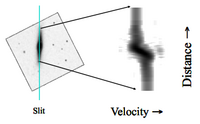Long-slit spectroscopy

Long-slit spectroscopy is a special way of looking at light that can tell us what something is made of. Imagine a flashlight shining on a wall - you can see the light, but you can't really tell anything else about it. But if you put a special pair of glasses on, you can break that light up into different colors, and suddenly you can see all kinds of amazing things!
Long-slit spectroscopy is like putting those glasses on for space objects like stars, planets, and galaxies. Astronomers use a special tool called a spectrograph to split the light from an object into different colors, just like the glasses. But with long-slit spectroscopy, we can do even more than that!
First, we need to get the right kind of light. We can't just use a flashlight - we need light from a star or galaxy we want to study. We point a telescope at that object and gather the light with a long, narrow slit in a special filter that separates the light into its colors like the glasses.
Then, we use a camera to take a picture of the slit and record all the colors of the light that's coming through it. By studying this picture, we can learn a lot about the object we're studying. We can tell how hot or cold it is, what its composition is, and even how fast it's moving!
So, in short, long-slit spectroscopy is like putting on special glasses to break up the light from space objects into different colors, helping us learn a lot of information about them.
Long-slit spectroscopy is like putting those glasses on for space objects like stars, planets, and galaxies. Astronomers use a special tool called a spectrograph to split the light from an object into different colors, just like the glasses. But with long-slit spectroscopy, we can do even more than that!
First, we need to get the right kind of light. We can't just use a flashlight - we need light from a star or galaxy we want to study. We point a telescope at that object and gather the light with a long, narrow slit in a special filter that separates the light into its colors like the glasses.
Then, we use a camera to take a picture of the slit and record all the colors of the light that's coming through it. By studying this picture, we can learn a lot about the object we're studying. We can tell how hot or cold it is, what its composition is, and even how fast it's moving!
So, in short, long-slit spectroscopy is like putting on special glasses to break up the light from space objects into different colors, helping us learn a lot of information about them.
Related topics others have asked about:
